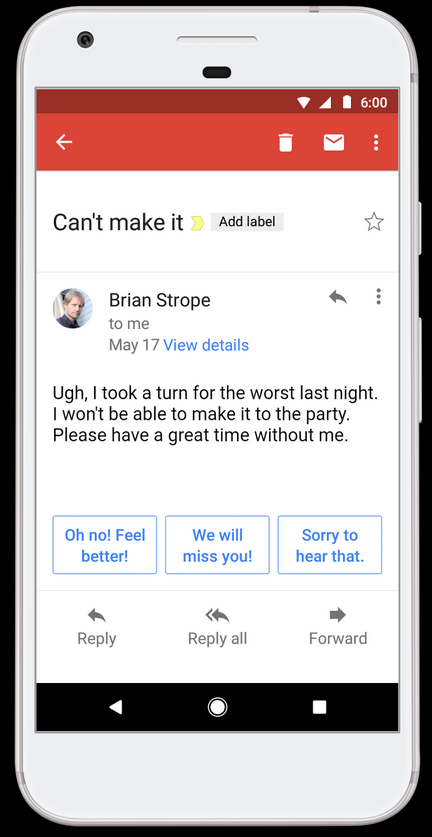How Google’s ‘smart reply’ is getting smarter
May 24, 2017

(credit: Google Research)
Last week, KurzweilAI reported that Google is rolling out an enhanced version of its “smart reply” machine-learning email software to “over 1 billion Android and iOS users of Gmail” — quoting Google CEO Sundar Pichai.
We noted that the new smart-reply version is now able to handle challenging sentences like “That interesting person at the cafe we like gave me a glance,” as Google research scientist Brian Strope and engineering director Ray Kurzweil noted in a Google Research blog post.
But “given enough examples of language, a machine learning approach can discover many of these subtle distinctions,” they wrote.
How does it work? “The content of language is deeply hierarchical, reflected in the structure of language itself, going from letters to words to phrases to sentences to paragraphs to sections to chapters to books to authors to libraries, etc.,” they explained.
So a hierarchical approach to learning “is well suited to the hierarchical nature of language. We have found that this approach works well for suggesting possible responses to emails. We use a hierarchy of modules, each of which considers features that correspond to sequences at different temporal scales, similar to how we understand speech and language.”*
Simplfying communication
“With Smart Reply, Google is assuming users want to offload the burdensome task of communicating with one another to our more efficient counterparts,” says Wired writer Liz Stinson.
“It’s not wrong. The company says the machine-generated replies already account for 12 percent of emails sent; expect that number to boom once everyone with the Gmail app can send one-tap responses.
“In the short term, that might mean more stilted conversations in your inbox. In the long term, the growing number of people who use these canned responses is only going to benefit Google, whose AI grows smarter with every email sent.”
Another challenge is that our emails, particularly from mobile devices, “tend to be riddled with idioms [such as urban lingo] that make no actual sense,” suggests Washington Post writer Hayley Tsukayama. “Things change depending on context: Something ‘wicked’ could be good or very bad, for example. Not to mention, sarcasm is a thing.
“Which is all to warn you that you may still get a wildly random and even potentially inappropriate suggestion — I once got an ‘Oh no!’ suggestion to a friend’s self-deprecating pregnancy announcement, for example. If the email only calls for a one- or two-sentence response, you’ll probably find Smart Reply useful. If it requires any nuance, though, it’s still best to use your own human judgment.”
* The initial release of Smart Reply encoded input emails word-by-word with a long-short-term-memory (LSTM) recurrent neural network, and then decoded potential replies with yet another word-level LSTM. While this type of modeling is very effective in many contexts, even with Google infrastructure, it’s an approach that requires substantial computation resources. Instead of working word-by-word, we found an effective and highly efficient path by processing the problem more all-at-once, by comparing a simple hierarchy of vector representations of multiple features corresponding to longer time spans. — Brian Strope and Ray Kurzweil, Google Research Blog.